 | | | Switch to: Europe, USA, New Zealand, Antarctica Credit: NOAA/Ovation  Planetary K-index Planetary K-index
Now: Kp= 1.67 quiet
24-hr max: Kp= 2.67 quiet
explanation | more data
Interplanetary Mag. Field
Btotal: 6.57 nT
Bz: -1.74 nT south
more data: ACE, DSCOVR
Updated: Today at 1147 UT  Coronal Holes: 23 Aug 24 Coronal Holes: 23 Aug 24 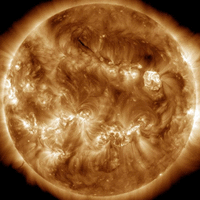
There are no significant coronal holes on the Earthside of the sun. Credit: SDO/AIA  Polar Stratospheric Clouds
Colorful Type II polar stratospheric clouds (PSC) form when the temperature in the stratosphere drops to a staggeringly low -85C. NASA's MERRA-2 climate model predicts when the air up there is cold enough: 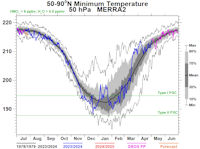
On Aug. 23, 2024, the Arctic stratosphere is much too warm for Type II polar stratospheric clouds. | more data. Noctilucent Clouds
The northern season for NLCs is underway--but not for long. The first clouds were detected inside the Arctic Circle on May 25, 2024, by the NOAA 21 satellite. After peaking in July, the clouds are now in rapid decline. This is typical for the month of August, which usually broings the end of NLC season in the northern hemisphere.
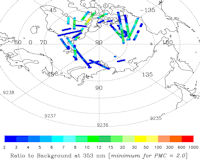
Updated: Aug. 22, 2024
An instrument onboard NOAA 21 (OMPS LP) is able to detect NLCs (also known as "polar mesospheric clouds" or PMCs). In the daily map, above, each dot is a detected cloud. As the season progresses, these dots will multiply in number and shift in hue from blue to red as the brightness of the clouds intensifies.
 SPACE WEATHER
NOAA Forecasts | | Updated at: 2024 Aug 23 2200 UTC FLARE | 0-24 hr | 24-48 hr | CLASS M | 70 % | 70 % | CLASS X | 15 % | 15 % |  Geomagnetic Storms: Geomagnetic Storms:
Probabilities for significant disturbances in Earth's magnetic field are given for three activity levels: active, minor storm, severe storm Updated at: 2024 Aug 23 2200 UTC Mid-latitudes | 0-24 hr | 24-48 hr | ACTIVE | 10 % | 10 % | MINOR | 01 % | 01 % | SEVERE | 01 % | 01 % | High latitudes | 0-24 hr | 24-48 hr | ACTIVE | 15 % | 15 % | MINOR | 20 % | 20 % | SEVERE | 15 % | 15 % | | | |  | | | | | | | | | | | This is an AI Free Zone! Text created by Large Language Models is spreading rapidly across the Internet. It's well-written, artificial, frequently inaccurate. If you find a mistake on Spaceweather.com, rest assured it was made by a real human being. | | | SUNSPOT NUMBERS AT A 20-YEAR HIGH: For the second month in a row, the monthly-average sunspot number is cruising toward a 20-year high. The current value, around 230, would eclipse every month since Sept. 2001, which occured during the peak of old Solar Cycle 23. The current cycle (Solar Cycle 25) was not supposed to be this strong, and it may become even stronger before Solar Max is finished. Solar flare alerts: SMS Text A HIGH-LATITUDE SUNSPOT: New sunspot AR3800 is not particularly big or flare-y, but it is interesting for another reason: It has a high latitude. The sunspot is growing in the southern hemisphere 27 degrees below the sun's equator: 
This may not sound particularly "high". On Earth, the 27th parallel (south) crosses places such as Namibia and Australia. These are not considered high latitudes. But for sunspots, which tend to cluster around the sun's equator, 27 degrees is indeed high latitude. So what? The potential significance of this sunspot is what it tells us about Solar Cycle 25. High latitude sunspots tend to appear early in the 11-year solar cycle, as shown in this plot from the Solar Terrestrial Center of Excellence: 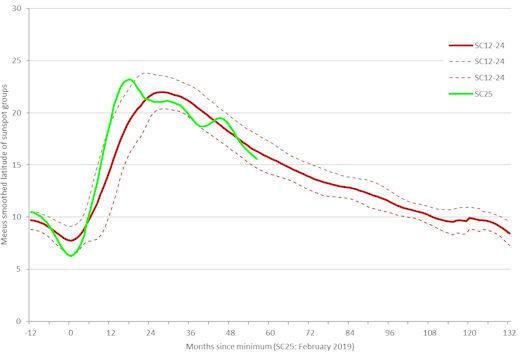
As solar cycles unfold, sunspots start high, then converge toward the equator. The existance of AR3800 is an anecdotal sign that we're still in the early stages of Solar Cycle 25. If so, strong solar activity is just getting started and may last for another 2 to 3 years. Solar flare alerts: SMS Text Realtime Space Weather Photo Gallery
Free: Spaceweather.com Newsletter EDGE OF SPACE BUTTERFLY: Are you looking for a far-out gift? Consider the Edge of Space Butterfly. On June 26th, this crystal pendant hitched a ride onboard an Earth to Sky Calculus cosmic ray research balloon:
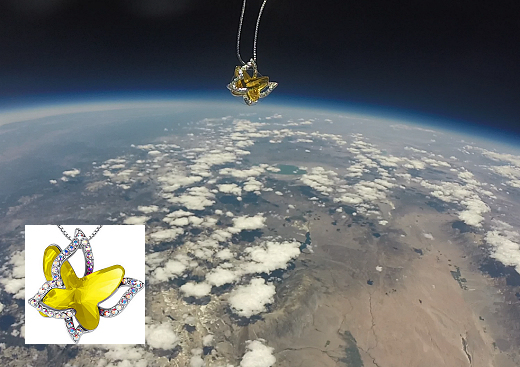
You can have it for $172.95. The inner yellow citrine crystal is surrounded by a "spread your wings" lattice of sparkling zirconia. A rich layer of rhodium plating ensures the longevity of the pendant and its 18-inch chain. The Edge of Space Butterfly makes a great anniversary, Christmas, or birthday gift. It comes with a greeting card showing the pendant in flight and telling the story of its trip to the stratosphere and back again. Far Out Gifts: Earth to Sky Store
All sales support hands-on STEM education
Realtime Aurora Photo Gallery
Free: Spaceweather.com Newsletter
Realtime Comet Photo Gallery
Free: Spaceweather.com Newsletter
Realtime Noctilucent Cloud Photo Gallery
Free: Spaceweather.com Newsletter Every night, a network of NASA all-sky cameras scans the skies above the United States for meteoritic fireballs. Automated software maintained by NASA's Meteoroid Environment Office calculates their orbits, velocity, penetration depth in Earth's atmosphere and many other characteristics. Daily results are presented here on Spaceweather.com. On Aug 23, 2024, the network reported 4 fireballs.
(4 sporadics) 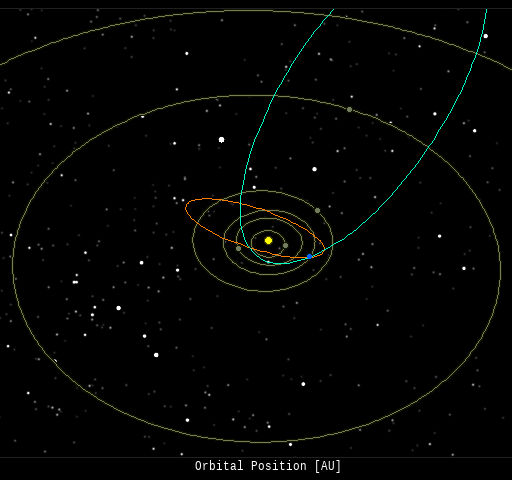 In this diagram of the inner solar system, all of the fireball orbits intersect at a single point--Earth. The orbits are color-coded by velocity, from slow (red) to fast (blue). [Larger image] [movies] Potentially Hazardous Asteroids ( PHAs) are space rocks larger than approximately 100m that can come closer to Earth than 0.05 AU. None of the known PHAs is on a collision course with our planet, although astronomers are finding new ones all the time. On August 23, 2024 there were 2349 potentially hazardous asteroids.
 | Recent & Upcoming Earth-asteroid encounters: | Asteroid | Date(UT) | Miss Distance | Velocity (km/s) | Diameter (m) | | 2024 QA | 2024-Aug-19 | 1.8 LD | 21.7 | 25 | | 2024 JV33 | 2024-Aug-19 | 12 LD | 11.1 | 184 | | 2024 PQ5 | 2024-Aug-20 | 13.5 LD | 12.6 | 43 | | 2020 RL | 2024-Aug-27 | 12.2 LD | 8.2 | 34 | | 2021 RA10 | 2024-Aug-28 | 6.8 LD | 4.9 | 29 | | 2012 SX49 | 2024-Aug-29 | 11.2 LD | 4.3 | 20 | | 2016 RJ20 | 2024-Aug-30 | 18.3 LD | 14.8 | 68 | | 2021 JT | 2024-Sep-01 | 16.4 LD | 8.2 | 12 | | 2021 RB16 | 2024-Sep-02 | 12.3 LD | 8.4 | 15 | | 2007 RX8 | 2024-Sep-02 | 18.5 LD | 7 | 44 | | 2022 SR | 2024-Sep-07 | 9.1 LD | 6.3 | 42 | | 2023 SP2 | 2024-Sep-09 | 15.3 LD | 4.2 | 8 | | 2024 PM6 | 2024-Sep-09 | 14 LD | 9 | 49 | | 2016 TU19 | 2024-Sep-11 | 13.2 LD | 10.1 | 47 | | 2019 DJ1 | 2024-Sep-15 | 10.4 LD | 4.9 | 15 | | 2024 ON | 2024-Sep-17 | 2.6 LD | 8.9 | 296 | | 2013 FW13 | 2024-Sep-18 | 8.5 LD | 15.6 | 162 | | 2022 SW3 | 2024-Sep-19 | 6.8 LD | 9.2 | 37 | | 2015 SH | 2024-Sep-19 | 11.6 LD | 5.9 | 9 | | 2023 RX1 | 2024-Sep-20 | 10.1 LD | 1.1 | 3 | | 2018 VG | 2024-Sep-20 | 13.4 LD | 7.3 | 12 | | 2020 GE | 2024-Sep-24 | 1.7 LD | 2.2 | 8 | | 2011 ST12 | 2024-Sep-27 | 17.6 LD | 7.4 | 19 | | 2023 GM1 | 2024-Oct-05 | 15.4 LD | 5.2 | 13 | | 2014 VA | 2024-Oct-05 | 18.1 LD | 6.3 | 46 | | 2022 SU21 | 2024-Oct-06 | 17.5 LD | 21.1 | 45 | | 671076 | 2024-Oct-07 | 12.8 LD | 8.6 | 120 | | 2016 JG38 | 2024-Oct-08 | 13.2 LD | 12 | 56 | | 2018 QE | 2024-Oct-09 | 1.7 LD | 4.4 | 10 | | 363027 | 2024-Oct-12 | 9.3 LD | 16.6 | 419 | | 2020 GE1 | 2024-Oct-12 | 20.1 LD | 4.3 | 14 | | 2022 UX1 | 2024-Oct-12 | 19.9 LD | 9.9 | 9 | | 2008 UU95 | 2024-Oct-12 | 13.5 LD | 15.6 | 66 | | 2021 TK11 | 2024-Oct-14 | 8 LD | 10.6 | 7 | | 2022 TB41 | 2024-Oct-15 | 10 LD | 6 | 4 | | 2019 UH14 | 2024-Oct-17 | 8.3 LD | 10.4 | 62 | Notes: LD means "Lunar Distance." 1 LD = 384,401 km, the distance between Earth and the Moon. 1 LD also equals 0.00256 AU. | | Cosmic Rays in the Atmosphere | SPACE WEATHER BALLOON DATA: Almost once a week, Spaceweather.com and the students of Earth to Sky Calculus fly space weather balloons to the stratosphere over California. These balloons are equipped with sensors that detect secondary cosmic rays, a form of radiation from space that can penetrate all the way down to Earth's surface. Our monitoring program has been underway without interruption for 7 years, resulting in a unique dataset of in situ atmospheric measurements. Latest results (July 2022): Atmospheric radiation is decreasing in 2022. Our latest measurements in July 2022 registered a 6-year low: 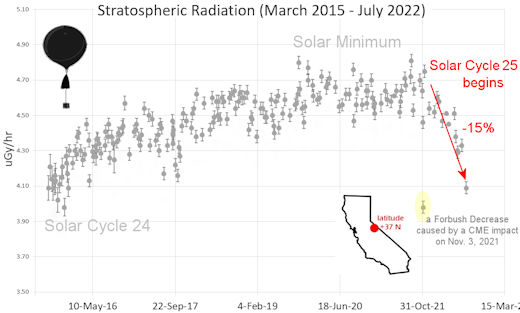
What's going on? Ironically, the radiation drop is caused by increasing solar activity. Solar Cycle 25 has roared to life faster than forecasters expected. The sun's strengthening and increasingly tangled magnetic field repels cosmic rays from deep space. In addition, solar coronal mass ejections (CMEs) sweep aside cosmic rays, causing sharp reductions called "Forbush Decreases." The two effects blend together to bring daily radiation levels down. .Who cares? Cosmic rays are a surprisingly "down to Earth" form of space weather. They can alter the chemistry of the atmosphere, trigger lightning, and penetrate commercial airplanes. According to a study from the Harvard T.H. Chan school of public health, crews of aircraft have higher rates of cancer than the general population. The researchers listed cosmic rays, irregular sleep habits, and chemical contaminants as leading risk factors. A number of controversial studies (#1, #2, #3, #4) go even further, linking cosmic rays with cardiac arrhythmias and sudden cardiac death. Technical notes: The radiation sensors onboard our helium balloons detect X-rays and gamma-rays in the energy range 10 keV to 20 MeV. These energies span the range of medical X-ray machines and airport security scanners. Data points in the graph labeled "Stratospheric Radiation" correspond to the peak of the Regener-Pfotzer maximum, which lies about 67,000 feet above central California. When cosmic rays crash into Earth's atmosphere, they produce a spray of secondary particles that is most intense at the entrance to the stratosphere. Physicists Eric Regener and Georg Pfotzer discovered the maximum using balloons in the 1930s and it is what we are measuring today. | | The official U.S. government space weather bureau | | | The first place to look for information about sundogs, pillars, rainbows and related phenomena. | | | Researchers call it a "Hubble for the sun." SDO is the most advanced solar observatory ever. | | | 3D views of the sun from NASA's Solar and Terrestrial Relations Observatory | | | Realtime and archival images of the Sun from SOHO. | | | information about sunspots based on the latest NOAA/USAF Active Region Summary | | | current counts of failed and deployed Starlink satellites from Jonathan's Space Page. See also, all satellite statistics. | | | Authoritative predictions of space junk and satellite re-entries | | | from the NOAA Space Environment Center | | | fun to read, but should be taken with a grain of salt! Forecasts looking ahead more than a few days are often wrong. | | | from the NOAA Space Environment Center | | | the underlying science of space weather |  | Got a chipped or cracked windshield that prevents you from seeing space weather events while driving? Get windshield replacement from SR Windows & Glass with free mobile auto glass service anywhere in the Phoenix area. |  | Marketing yourself on YouTube is hard without real organic views on your videos. You can buy organic YouTube views from and enjoy social boosting that is actually real. Highly recommended! |  | BestCSGOGambling is the best site for everything related to CSGO gambling on the web | | | These links help Spaceweather.com stay online. Thank you to our supporters! | | | | | | | | |  | |  |   | ©2021 Spaceweather.com. All rights reserved. This site is penned daily by Dr. Tony Phillips. | |

